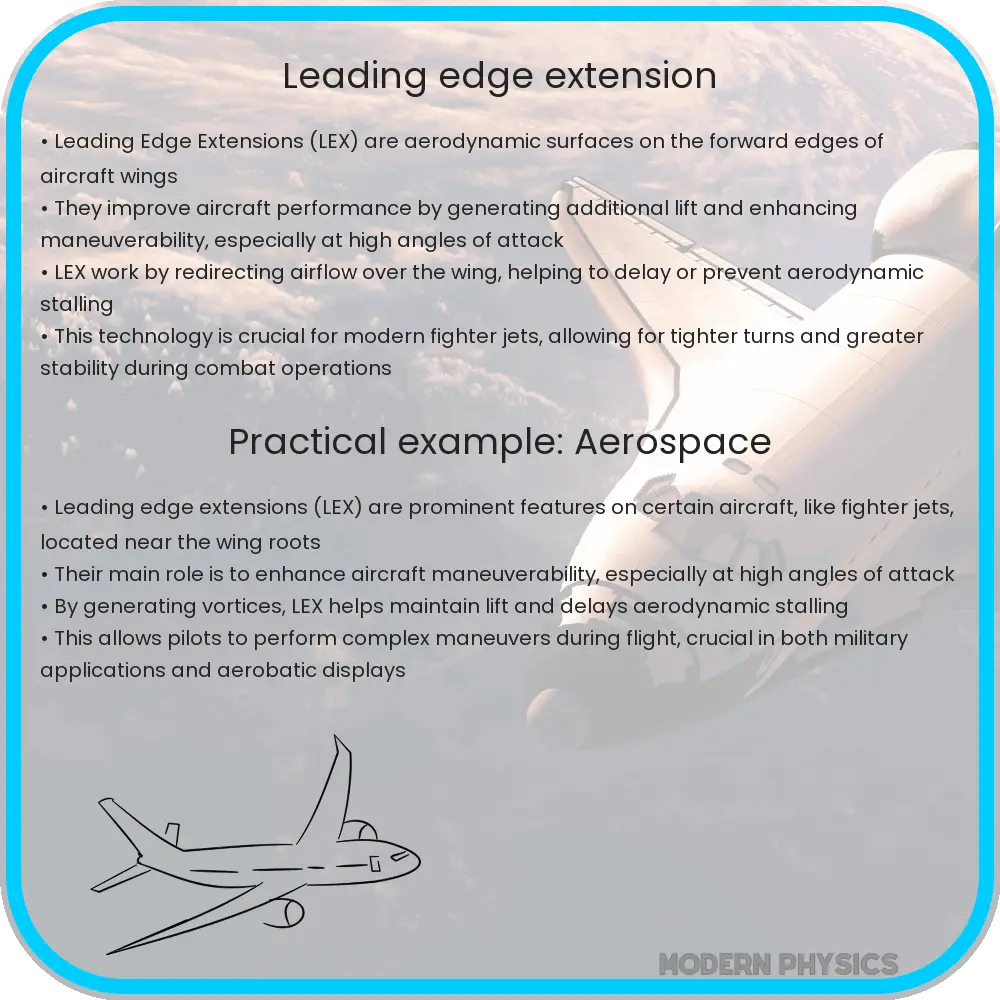Leading edge extensions enhance aircraft lift and control, critical for maneuverability and performance in flight.

Understanding Leading Edge Extensions in Aircraft Wing Design
Leading edge extensions (LEX) are an important feature in modern aircraft design, particularly visible in combat aircraft. These aerodynamic surfaces have a significant effect on the aircraft’s ability to generate lift and control flow, impacting overall maneuverability and performance. This article explores how leading edge extensions work within the realms of hydrodynamics and aerodynamics to enhance the capabilities of an aircraft.
The Role of Leading Edge Extensions
Leading edge extensions are small aerofoil surfaces that extend from the front of the wing towards the fuselage or the nose of the aircraft. They are typically found on the wings of high-performance fighter jets, such as the F-18 Hornet and the Sukhoi Su-27. The primary function of the LEX is to improve the aircraft’s lift characteristics at high angles of attack and during high-agility maneuvers.
Hydrodynamics and Lift
In physics, lift is the force that directly opposes the weight of an aircraft and holds it in the sky. Lift is generated by the movement of the aircraft through air, a fluid medium, which obeys the principles of hydrodynamics. According to the Bernoulli’s Principle, an increase in the speed of the fluid occurs simultaneously with a decrease in pressure.
The leading edge extension modifies the flow of air around the wing. By extending the leading edge, the LEX encourages the air to flow smoothly over the wing surface even at higher angles of attack, where the risk of airflow separation and subsequent stall is significantly increased. This flow control is crucial during critical phases of flight, such as takeoff and landing, or when performing complex aerial maneuvers.
How LEX Affects Airflow and Aircraft Stability
The aerodynamic benefits of leading edge extensions are primarily attributed to their ability to generate a high-lift vortex. At high angles of attack, the leading edge of the wing typically encounters airflow separation; however, with an LEX, a controlled vortex is generated. This vortex acts to energize the flow on the upper surface of the wing, delaying or preventing stall.
Furthermore, these vortices enhance the ability of the wing to produce lift while also increasing drag slightly. The trade-off typically results in better handling characteristics at lower speeds and higher angles of attack, which is vital for fighter jets engaged in close-range combat or during takeoff and landing phases.
Impact on Aerodynamic Efficiency
The introduction of leading edge extensions isn’t without its drawbacks. While they enhance lift and handling, they can also increase aerodynamic drag. This increase in drag can affect the overall efficiency of the aircraft, as more fuel may be required to overcome the additional resistance during flight. However, in combat and high-performance aircraft, the trade-off is often considered worthwhile for the gain in maneuverability and safety.
Additionally, the integration of LEX into aircraft design must be meticulously planned and tested. The size, shape, and angle of the LEX can vary significantly between different aircraft models, each tailored to the specific aerodynamic needs of the vehicle. Advanced computational fluid dynamics (CFD) simulations and wind tunnel testing are crucial in optimizing these features for any new aircraft design.
Engineering Considerations
From an engineering perspective, the incorporation of leading edge extensions presents a variety of challenges. Material selection, structural integrity, and maintenance of the LEX are paramount. The materials used must withstand the high dynamic pressures and temperature variations experienced at the leading edges during flight. Furthermore, the design must integrate seamlessly with the existing wing structure to maintain aerodynamic efficiency and mechanical reliability.
In summary, leading edge extensions play a pivotal role in the aerodynamic performance of aircraft, particularly in enhancing lift and controlling flow at high angles of attack. Their design and implementation involve a careful balance of aerodynamic benefits against potential increases in drag and structural considerations. As aviation technology progresses, the use of LEX might see even broader applications in commercial and private aviation beyond its predominant use in military aircraft.
Future Developments and Innovations in LEX Technology
As aerospace technology continues to advance, the development of more sophisticated leading edge extensions is likely. Innovations may include adaptive LEX that can change shape or orientation in response to flight conditions, thereby optimizing performance dynamically. Such developments could further enhance the maneuverability and efficiency of aircraft, potentially extending into commercial aviation where improved lift and reduced fuel consumption are critical.
Moreover, the integration of materials science advancements could lead to lighter, stronger LEX designs. Composites and advanced alloys that offer superior strength-to-weight ratios are envisaged to play a key role. These materials would not only improve the aerodynamic performance but also contribute to the overall sustainability of aircraft by reducing the carbon footprint associated with heavier designs.
Conclusion
Leading edge extensions represent a crucial element in modern aircraft design, particularly for high-performance and combat aircraft. By optimizing lift and controlling airflow around the wings at critical angles of attack, LEXs enhance both the safety and maneuverability of aircraft. The trade-offs between increased lift and additional drag are considered acceptable in scenarios where enhanced performance is essential.
The ongoing advancements in computational fluid dynamics and materials science promise even more effective implementations of LEX in future aircraft designs. As engineers continue to refine these aerodynamic components, we can anticipate more efficient, safer, and possibly more environmentally friendly aircraft. Ultimately, the evolution of leading edge extensions will continue to be an important aspect of aerospace engineering, pushing the boundaries of what is achievable in aviation technology.
